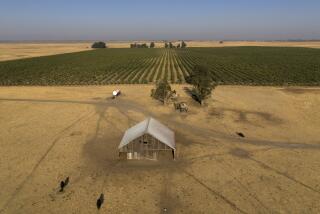Caltrans Shelves Plans for Overpass : Calabasas: A controversial Valley Circle Boulevard bridge may be reconsidered in 2 years. Officials blame a lack of funds; activists cite faulty planning.
Plans for a controversial Ventura Freeway interchange in Calabasas that officials hoped would be under construction by mid-1991 have been shelved for reconsideration in two years for reasons that--like the project itself--are the subject of dispute.
California Department of Transportation officials announced Monday that the state cannot afford its share of the cost of the project. By the time the money is available, they said, the project will have to be redesigned to take into account growth and development in the area.
But a lawyer representing four homeowner groups opposed to the design said Caltrans is backing off because engineers now realize they underestimated future roadway use.
“We are expecting to have a $3.5-billion deficit in our State Transportation Improvement Plan and that’s why we scrapped the project,” Ken Nelson, Caltrans project design director, said Monday. “We have $200 million worth of projects that are fully designed and on the shelf,” he told a meeting in Woodland Hills of about 20 homeowners, business leaders and representatives of elected officials.
Nelson said that if voters approve Proposition 111, the gasoline tax measure that would raise $1.5 billion annually for highway improvements, then Caltrans will recycle the project by reconsidering its design in light of changes and growth in the area. That process will take at least two years.
Even if the proposition passes, it will not raise enough money in the first two years for all Caltrans’ planned projects. And, if the proposition does not pass, “You won’t see this or any other highway projects for a very, very long time,” Nelson said.
The design of the proposed interchange, to be built where Valley Circle Boulevard meets the Ventura Freeway, annoyed residents, who have lawsuits pending against Caltrans in state and federal courts demanding that the agency prepare an environmental impact report on the project.
Although residents wanted a solution to traffic bottlenecks on the 1950s-era interchange, they objected to the Caltrans proposal because they said it would destroy the quaint ambience of Old Town Calabasas and threaten the historic Leonis Adobe. As part of the project, Caltrans planned a “flyover bridge” above the freeway to connect two-lane Calabasas Road with four-lane Ventura Boulevard.
Nelson denied Monday that community sentiment or the lawsuits played a role in the Caltrans decision.
“The opposition was not a factor at all,” Nelson said. “We dropped it because we have no money.”
However, Jack Rubens, the attorney representing the four homeowners groups and the nonprofit Leonis Adobe Assn., said he believes Caltrans delayed the interchange because the agency designers used a flawed traffic analysis that underestimated future use of the roadway and the agency needed to redesign the project. That was one of the contentions of the homeowners’ lawsuits.
“They are trying to pretend that the lawsuit had nothing to do with dropping the plan, but I am sure it was the motivating factor behind their decision,” he said.
Although some residents were pleased that the unpopular “flyover” design will be reconsidered, others were unhappy that traffic problems will continue.
“I couldn’t have imagined in my worst nightmare that this would take another two years,” said Michael Schaaf, who lives next to the site of the proposed interchange. “As it is, you have to have the reflexes of a karate master to enter Valley Circle Boulevard from our neighborhood, and the traffic is only getting worse.”
Representatives of elected officials said they are still committed to increasing the capacity of the interchange. But they cautioned that residents could jeopardize future funding if they take issue with the design after Caltrans reworks the proposal. If the project is recycled, Caltrans could recommend a completely different design.
“If people next time don’t support the preferred alternative, it will be very difficult to keep Caltrans involved in the project,” said Hunt Braly, a representative of state Sen. Ed Davis (R-Santa Clarita). “We need a renewed commitment from the citizens to work for an improved interchange.”
Elaine Miller, a representative of state Sen. Gary K. Hart (D-Santa Barbara), said that when Caltrans makes public its next design, Calabasas residents should remember “any good outcome requires compromise. We all have to be willing to accept less that what we would consider the perfect design.”
But Nelson warned that the debate will be moot if Proposition 111 fails in June.
More to Read
Sign up for Essential California
The most important California stories and recommendations in your inbox every morning.
You may occasionally receive promotional content from the Los Angeles Times.









